|
Handheld Nautiz X1
A light and elegant ultra-rugged, capacitive touch Android smartphone/mobile computer for those situations where even an "active" smartphone just won't do
By Conrad H. Blickenstorfer; photography by Carol Cotton
There was a time when phones were just that, phones, and the tinier the better, and where industrial mobile computers were big and bulky. That's no longer the case. Phones have become mobile computers and they've been growing ever larger, while mobile computers have become smaller and more phonelike both in features and in appearance. The Nautiz X1 from the Handheld Group is a perfect example. It's a fully rugged ultra-compact handheld computer that also has full smartphone capabilities. In this article we're taking a detailed look at the Nautiz X1, and what customers can expect from it.
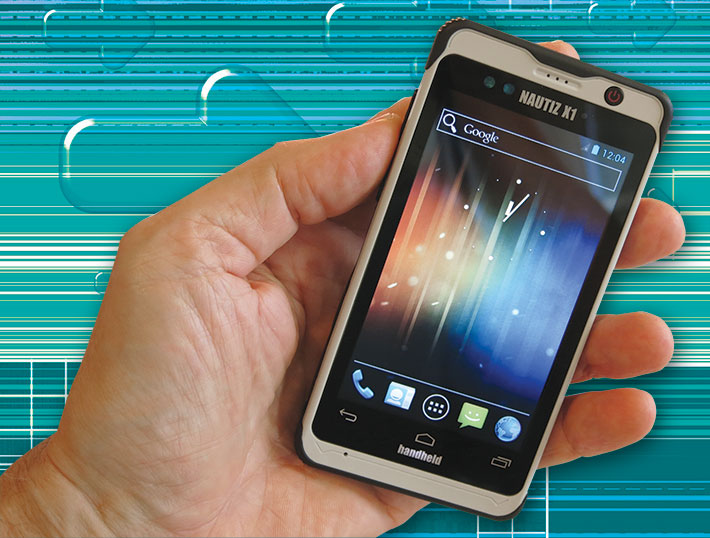
Handheld Group initially announced the Nautiz X1 late 2012 as an addition to the company's line of rugged handheld computers that also includes the Nautiz X3, X4, X5, X7, and X8. The announcement created a lot of attention as the X1 was the company's first Android device and, in fact, one of the world's first truly rugged Android smartphones.
That was huge, considering that many hundreds of millions of people are already familiar with the Android OS and the effortless way of interacting with it through a capacitive multi-touch screen. Android's commanding market position suggested an increasing demand for Android smartphones in business and in the field where they must be tougher and more durable than consumer phones. Now add to that the fact that most ruggedized handhelds still use the older Windows Mobile, and the opportunity for devices such as the Nautiz X1 seems tremendous.
Blending of an ultra-rugged handheld and an enterprise smartphone
Right upfront, do note that the folks at Handheld consider the X1 primarily a tough, ultra-compact mobile computer, and only secondarily a smartphone. Their emphasis was creating a device that could survive intense environmental conditions and the kind of abuse encountered on the job, rather than making a fashion statement.
That said, let's put things in (size) perspective. The Nautiz X1 measures 4.9 x 2.6 inches, is 0.6 inches thick, and weighs 6.3 ounces. That's a bit thicker and heavier than today's consumer smartphones,  but a funny thing has happened since the Nautiz X1 was first conceived. Handheld's smallest platform was probably meant to be no larger than a modern smartphone and the company certainly met that goal. but a funny thing has happened since the Nautiz X1 was first conceived. Handheld's smallest platform was probably meant to be no larger than a modern smartphone and the company certainly met that goal.
What probably no one expected as recently as a couple of years ago was that the trend in consumer phones went in the other direction. Attempting to somehow differentiate themselves from the iPhone, Samsung and others made their phones larger. That move was so successful that Apple itself had to follow suit, and the result is shown on the right.
The lineup shows — from left to right and in scale — the Nautiz X1, and Apple's iPhone 5, and the new iPhone 6 and iPhone 6+. So while the Nautiz X1 is only about the size of an iPhone 5 despite its vastly greater ruggedness, it's now dwarfed by the latest iPhones. Ironically, it's now Apple's consumer phones, and especially the iPhone 6+, that are criticized for barely fitting into pockets anymore, whereas the Nautiz X1 is compact enough to fit even into the tightest jeans pocket. Go figure.
Tech and spec
In terms of technical specifications, the Nautiz X1 uses a dual-core Texas Instruments OMAP 4430 processor running at 1GHz. That's the same chip used in tablets such as the Getac Z710 and enterprise smartphones such as the Motorola LEX 700. There is 1GB of RAM and 2GB of Flash, expandable via micro SDHC card. If 2GB seems modest compared to the usual 16/64/128GB in iPhones, the amount of built-in storage hardly matters if the device can use expansion cards..
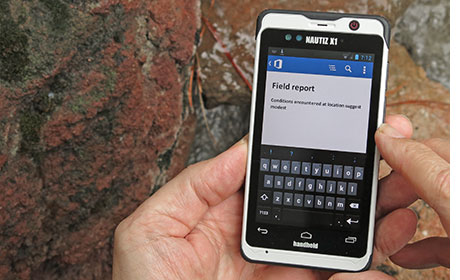 The sunlight-readable display measures a handy 4.0 inches diagonally, which is larger than most displays found on rugged and industrial handheld devices. We certainly appreciate the extra space. The sunlight-readable display measures a handy 4.0 inches diagonally, which is larger than most displays found on rugged and industrial handheld devices. We certainly appreciate the extra space.
The Nautiz X1 follows iPhones and Android smartphones in that it uses projected capacitive ("procap") multi-touch instead of the resistive digitizer common to almost all older handhelds.
That is actually a major step, as an argument against the use of procap in rugged devices used to be that the technology doesn't work in the rain or with gloves on. While that is mostly true, it hasn't stopped consumer market procap smartphones selling by the hundreds of millions, and consumers use their phones in the rain and when they wear gloves. This is a case where the great benefits of procap outweigh a couple of limitations.
The Nautiz X1 also isn't lacking in other consumer smartphone goodies. The device has a 5-megapixel autofocus camera with LED flash for documentation purposes, a G-sensor for motion-dependent apps and functionality, an e-compass, and real GPS (as opposed to A-GPS that depends on the presence of a data network signal). Wired connectivity is via micro USB OTG (OTG stands for "On The Go" and allows devices to act as both USB hosts or clients) and a 5-pin USB docking connector.
For wireless connectivity there is Bluetooth Class 2 (the kind with a range of about 33 feet or 10 meters), 802.11b/g/n WiFi, and 3G mobile broadband of the GSM/GPRS/EDGE, UMTS/HSPA+ variety.
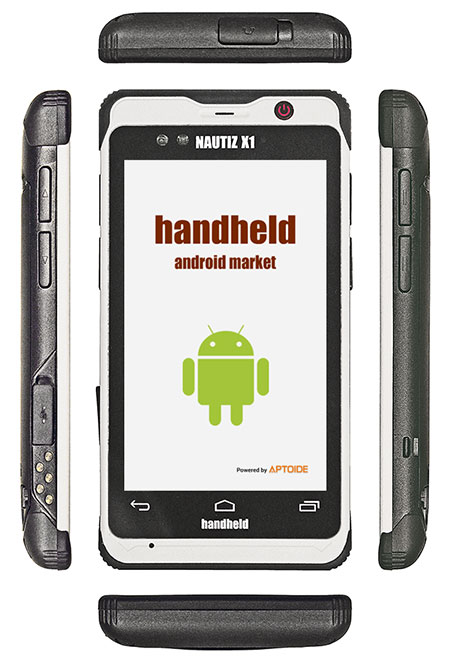 The picture to the right shows the Nautiz X1 from the front and from all four sides. Like all of the Handheld Group's devices, it's an elegant design employing the company's signature off-white and black color scheme and school of design. The picture to the right shows the Nautiz X1 from the front and from all four sides. Like all of the Handheld Group's devices, it's an elegant design employing the company's signature off-white and black color scheme and school of design.
However, despite its small size, the X1 looks and feels rugged and purposeful at the same time. The sense you get is that of a tool for the job rather than the latest fashion statement for texting and the like.
Going around the Nautiz X1:
As is the case with all of the Handheld Group's designs, the X1's housing is elegant, clean and functional. There are no visible screws and few small parts or details that look like they could break off. The device feels very solid and suitable for hard use in the field. The black rubberized bumpers are design elements as well as protection. They are bonded to the housing in a process called double injection.
An inside look at the Nautiz X1
Consumer smartphones have not only been getting larger over the past couple of years, they've been getting ever thinner as well. The unfortunate byproducts of these fashion trends are an alarming loss of rigidity and an equally alarming loss of what the people at iFixit.com call repairability. Both are unacceptable to industrial and enterprise users. In those markets, while good looks may make a first impression, it's functionality and durability that count. To us, that means it's what's inside that really matters in a device that must hold up to rough treatment.
The pictures below show the backside of the Nautiz X1, both with the battery compartment cover off and with the battery removed. You can also see the user-accessible SIM card and microSD card slots inside the compartment. The user-replaceable battery means an opening to the interior of the device, which means a seal is required.
This is accomplished via a flat pressure seal that goes around the inside perimeter of the plastic battery compartment cover which snaps on, and is securely held in place with two rotating levers that can be operated with a fingernail.
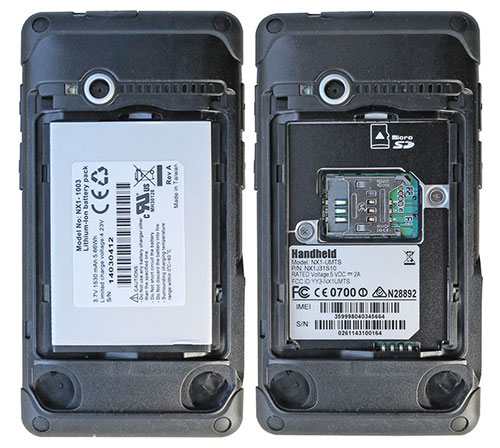
For construction, the Nautiz X1 consists of a light-gray polycarbonate upper half and black polycarbonate lower half held together by four T5 Torx screws plus a couple of tiny Philips screws. In a testimony to the Handheld Group engineers' attention to detail, the four Torx screws have tiny rubber washers, and then rubber sealer caps on top, cut so that they neatly fit into the curved part of the housing.
The two halves easily come apart, with just a single narrow ribbon cable connecting the two sides, and revealing a tongue and groove seal between the halves. An o-ring seal sits in the groove and it sits tightly so it can't get lost. The bottom half has a metal insert where the battery sits. The top part is light-gray plastic and has the LCD and motherboard mounted onto it. Each half has rubber overmold areas for extra corner protection.
Below you can see what the Nautiz X1 looks like inside. This is something few end user will ever see as there is no need to ever disassemble the device other than for repair or servicing. What we're looking at here is one side of the motherboard. As in the Nautiz X4 that we recently analyzed, a unique aspect is that the designers incorporated electronic modules into black plastic subframes instead of directly mounting them on the motherboard.
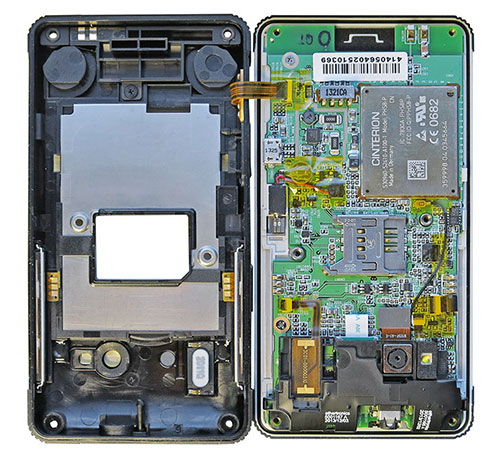
Another signature detail is that Handheld applied small strips of yellow adhesive tape to secure interior connectors. It's unlikely they'd ever rattle loose, but this is the sort of extra effort we like to see.
We usually identify components as it's always good to know what's inside one's tools. In the Nautiz X1 we found:
- A dual-band Cinterion PHS8-P HSPA+ cellular module with full voice support. It offers five bands UMTS for true global roaming and two local variants, the PHS8-US (USA) and PHS8-E (Europe) (see here and here for the PHS8 PDF product sheet).
- A very compact (6.5 x 8 mm) standlalone uBlox AMY-6M GPS module (see AMY-6M PDF), and what looked like Ethertronics antenna gear.
When we reviewed Handheld's Nautiz X3 we had had some concerns about that unit's combining USB, power and audio all into one non-standard universal port. We prefer the X1's arrangement that does have a dock connector but also separate USB and audio ports. The only problem is that standard micro-USB ports are inherently flimsy and easy to damage, plus one never knows which way a plug goes in, and forcing it can have dire consequences.
Overall, as we've come to expect from Handheld Group products, the interior of the Nautiz X1 is well engineered, clean and solid, and there aren't any fixes or unfinished looking areas. Everything is tightly secured, nothing rattles or seems in danger of coming loose.
Modern display — 4-inch and procap multi-touch
The 4-inch Nautiz X1 display offers WVGA resolution, which means 800 x 480 pixel. That's an awful lot compared to the old QVGA (320 x 240) Pocket PC era, but not all that much compared to state-of-the-art consumer smartphones that now routinely have full 1080p 1920 x 1080 pixel displays, and some even higher. So where does that leave the X1? In a pretty good position. 800 x 480 on a 4-inch screen means about 232 dots per inch, which is far more than the original iPhone (163 dpi), let alone even highly touted desktop machines such as the iMac27 (about 108 dpi). It's a bright, very sharp display.
The pictures below show a comparison between the Nautiz X1 and an iPhone 4S outdoors, both at maximum brightness. Head-on the X1 is brighter, viewed from an angle it tended to look a little dimmer. Both displays have some reflection, but in a handheld that's much easier to live with than with a tablet's larger screen.
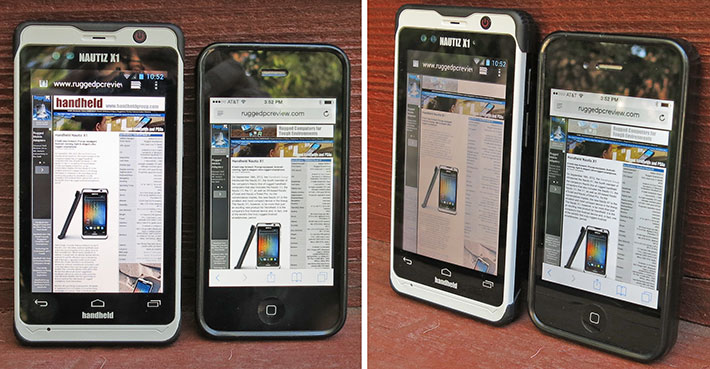
Capacitive touch works as expected — quickly and effortlessly. The X1's touch controller is more sensitive than that in the comparison iPhone 4S and responded through thicker layers of material than the iPhone's. There's also an optional capacitive pen, but it seems to be one with a wide tip, and not one suitable for precision work, like the Wacom-based pen in some Samsung "phablets" or to the next-gen capacitive pen in the Panasonic FZ-M1.
Android (or Windows Embedded Handheld)
Probably in an effort to hedge bets and also cover as many different customer demands as possible, Handheld makes the Nautiz X1 available either with Android 4.04 or with Microsoft Windows Embedded Handheld 6.5.
Android will likely appeal to those who are already using Android smartphones and/or tablets at home or at work. The Android interface is very widely known by now, a very large number of apps are available for download, Android software development is readily available, and making it all available on the job as well can save training costs as well as deployment costs.
Windows Embedded Handheld still appeals to enterprises that have an existing investment in Microsoft mobile infrastructure. While Windows Mobile really hasn't been available on any consumer devices in years, it remains a reliable, easy-to-integrate OS platform for vertical and industrial markets.
As is, our review unit came with Android which is a natural match for the Nautiz X1 hardware with its capacitive multi-touch display. Android was developed with procap in mind, whereas Windows Embedded Handheld was not. That's not to say that the X1 doesn't work well with Windows, it's just that all Android software was developed for procap, while most Windows Mobile apps were not.
Android contemplations
A few words about one of the issues facing Android in industrial and enterprise markets. Among the most attractive features of any modern smartphone is that users can easily download apps from their OS platform's marketplace. For Apple products that's the App Store. For Android it's the official Google Play store, but also third party app stores such as the Amazon Appstore for Android, Slide ME, and a number of others. The issue is obvious: businesses likely do not want their staff downloading apps into devices used for work. How is that handled?
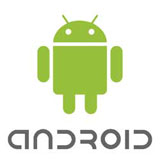
One approach is to use Android AOSP, which stands for Android Open Source Project, and is an open-source software stack and project, led by Google itself, but without the ability to use the Google Play store and some of the major Google apps. Android AOSP, however, still has access to alternate app stores.
Another possibility is using something like 42Gears.com's SureLock. SureLock replaces the Android desktop and allows control of applications that are available to users. It can even be configured to run in "kiosk mode" with just a single application that is always active. This way, systems integrators or IT personnel can configure units for specific use and applications, eliminating the temptation that comes with a full load of consumer apps.
Our review Nautiz X1 came with a full complement of apps, and it also had "Handheld Market" on it, Handheld logo and all. That's because Google makes it possible for organizations to publish their own Android apps or officially sanctioned apps privately to a dedicated company-owned channel on Google Play. We have asked Handheld about their approach and will add the information to this review.
The pictures below show the Nautiz X1 Welcome screen (left) and Apps screen (center), as well as the File Manager screen with all the folders and search and navigation.
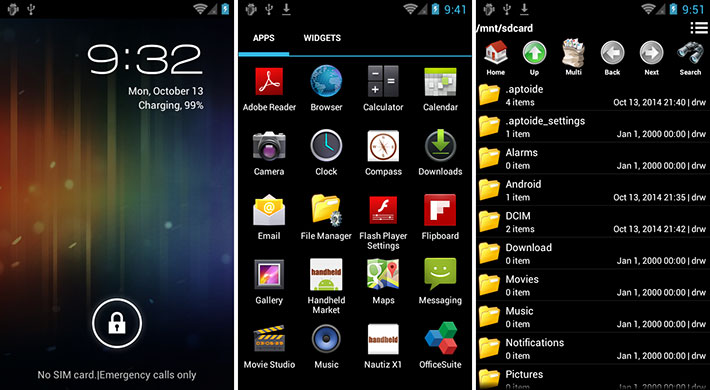
Anyone who has ever used an Android device (over two billion by now) will, of course, be familiar with one implementation of the Android interface or another, but we're including some screen snaps anyway, courtesy of the ddms app in the Android SDK.
Almost anyone will wonder if it's possible to use Microsoft Office on the Nautiz X1, and the answer is yes. Office Mobile can be downloaded from the Handheld Market and used for free as long as the user has an Office 365 account with Microsoft. OneDrive users can then easily use on their X1 whatever Word and Excel documents they have in Microsoft's cloud.
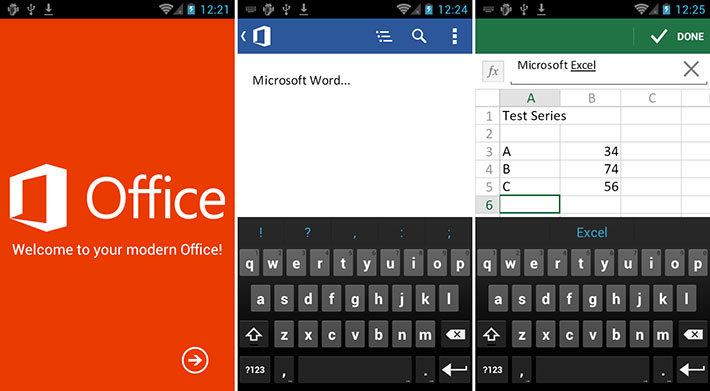
Google Maps was already installed on our eval X1, and it's a natural for the Nautiz X1 with its bright, responsive screen and integrated GPS.
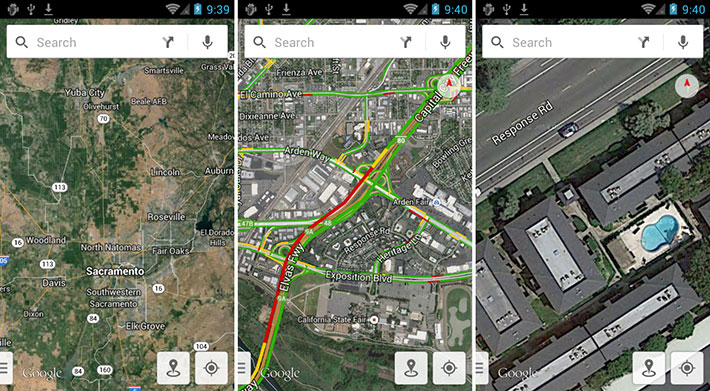
While web browsing on a 4-inch display isn't the greatest thing ever (which is likely a good part of the reason why consumers demanded those big smartphone screens), but thanks to the Android, capacitive touch, the X1's sharp display and the touch-optimized browser, it works very well. And, of course, panning, zooming and pinching makes it easier yet.

The Handheld Group also included a special Nautiz X1 app that's a bit like the dashboards found on many tablets for easy one-tap access to important and frequently used functions. On the X1, the app can be used to launch barcode reading, compass, GPS, power usage, install OS upgrades from cards, get system info, and even use the X1 as a flash light. The utility is likely a demo that shows how enterprise customers may provide access to dedicate software suites, etc.
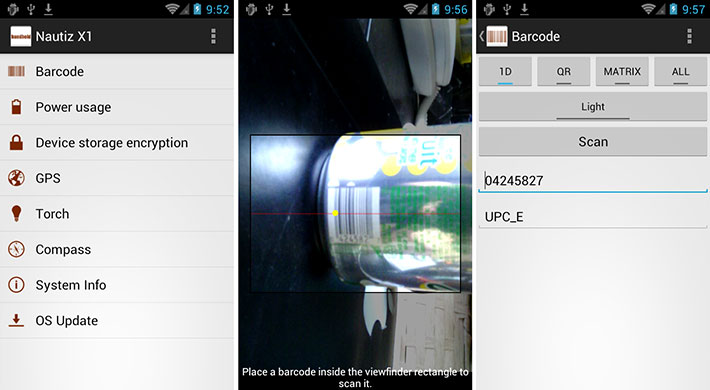
What it all means is that the Nautiz X1 can be used as a standard Android device with standard Android apps and access to a vast amount of downloadable software, or it can be configured and used as an Android-powered mobile computer for dedicated and very specific tasks.
Phone functionality
These days almost everyone has a supremely competent consumer smartphone, and it seems hardly necessary to highlight the phone capabilities of a rugged mobile computer. But while Handheld doesn't call the device a smartphone, the Nautiz X1 does have physical phone pickup and hangup buttons along its right side, and it can definitely be used as a phone. Simply insert a SIM card and as long as you have an activated account for it, the X1 becomes a powerful smartphone.
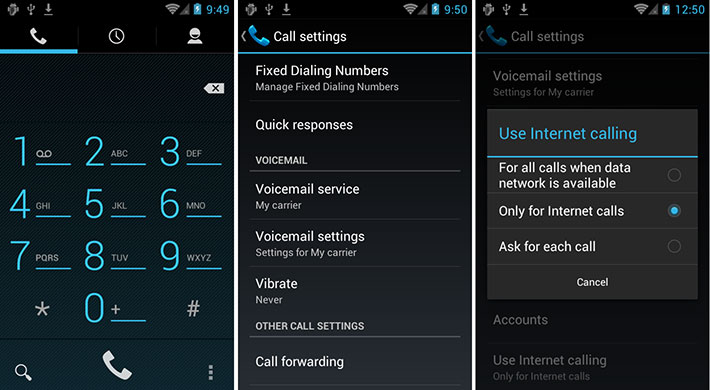
What all this means is that the Nautiz X4 can be used as a phone in addition to everything else it does.
Workable camera
All modern smartphones have built-in cameras these days, and those cameras are now so good that they have not only pretty much eliminated the dedicated point & shoot camera market, they are now being compared by the trade media to digital SLRs. This means that very high quality camera circuitry is available and fits into very small spaces. Unfortunately, cameras built into vertical market rugged handhelds have consistently lagged behind. That's most unfortunate as the idea behind adding camera functionality to such devices is to allow their users to document field conditions, findings, reports, etc. Has Handheld given the Nautiz X1 a better camera?
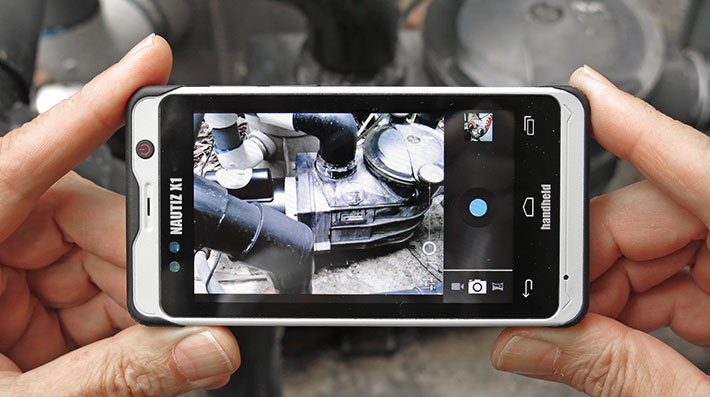
The answer is a qualified yes. The Nautiz X1's integrated camera can take images with resolutions of up to five megapixel. It also has an LED illuminator that you can turn on and off via software to add extra light. It's not a flash, but can help generating better close-up pictures.
Cameras in computing devices usually seek to emulate all the settings available in dedicated cameras, and though the X1 camera app works pretty much like your typical smartphone camera, there are also numerous settings. You can set the flash, white balance, exposure compensation, scenes, ISO, saturation, sharpness, and plenty more, almost 20 settings in all. The camera takes pictures from lowly QVGA all the way to 2592 x 1944 pixels. You can play slide shows, do basic editing, designate a picture as wallpaper or contact photo, share shots via Bluetooth or messaging, and so on. In video mode you can record at up to 1280 x 720 pixel 720p format, and you can set white balance, bit rate, audio and video encoder, and a recording timer.
The screen snaps below show some of the camera settings screens, and what it looks like in picture-taking mode.
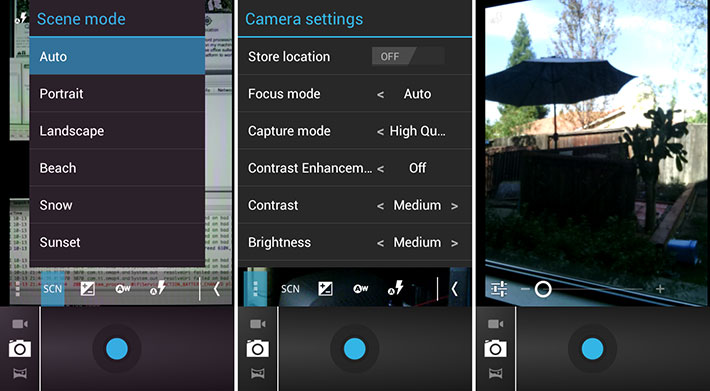
In an era of smartphones with 12 and 14-megapixel cameras that can also do full 1080p HD video, sometimes even at 60fps, the above specs and capabilities are only so-so. But they are far superior to anything we saw in the past in mobile computers. Below are some sample shots we took with the X1 camera. Click on the picture to get a full-size version.

The Nautiz X1 camera is capable of taking much better pictures than we generally see from industrial handhelds. There is good sharpness and image detail, and little of the massive compression that often renders pictures from such integrated cameras useless.
Video, likewise, is much improved compared to what we're used to seeing from cameras integrated into rugged devices. Frame rate and focussing are quick enough to be used on the job, though the autofocus occasionally hunts and the camera sometimes falls a bit behind. The maximum 1280 x 720 recording format, though, is very useful. The video to the right was taken with the X1 camera in 720p resolution. It's an example of a clip that a mechanic might shoot as an attachment to a work order.
Note that the camera applications that come with mobile operating systems are often replaced with third party applications optimized for certain tasks, or developers and systems integrators include camera and video functionality directly into custom applications.
From what we can tell, the still image and video functions of the X1 are good enough for many documentation jobs.
Power — standard or extended
The Nautiz X1 is powered by a rechargeable 1,530mAh 3,7 Volt Lithium-Ion battery. This amounts to 5.66 watt-hours—workable for this class of device. Handheld's X1 brochure promises "extended operation, even on long days away from a power source." If more is needed, there's an optional 2,920mAh battery with almost twice the capacity. The battery compartment cover with its rotating security levers can easily be opened, making battery replacement in the field, or almost anywhere, a simple task.
Ruggedness — ain't gonna break
Since a major weak spot of consumer smartphones is their fragile construction and tendency to get damaged or break even from minor mishaps in regular daily use, providing significantly more ruggedness is a good part of the Nautiz X1's mission. Does it deliver?
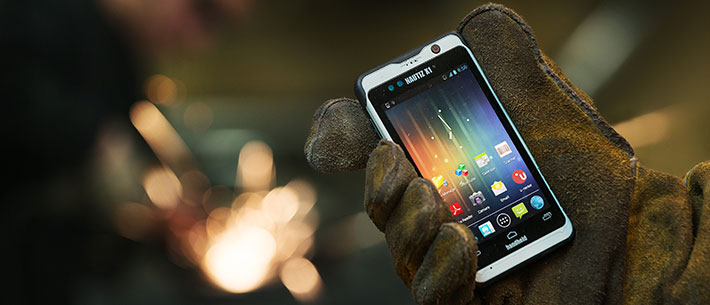
Yes, and that's what truly sets the Nautiz X1 apart from those hundreds of millions of consumer smartphones. It's tough and rugged and can survive out there in the field.
First, the Nautiz X1 carries IP67 sealing where the "6" means it's totally dustproof, and the "7" that it is also waterproof down to about three feet. That quality is actually now being offered in some consumer phones, but it's still good to know that one's handheld can easily survive even a fall into a puddle or stream.
Second, the operating temperature range is a very wide -4 to 140 degrees Fahrenheit (-20 to 60 Celsius), which means it can be used almost anywhere. That seems like it should be a given, but consumer phones often simply shut down when they get too hot. The X1, on the other hand, can be used in freezers as well as desert-like conditions.
Third, the device can also handle repeated drops from four feet. Consumer phones need a case for that, and even then there's no guarantee that they can survive a drop, let alone multiple drops.
In addition, the Nautiz X1 has been MIL-STD-810G tested for a variety of other ruggedness criteria. Vibration can be an issue if a device rattles around in a vehicle or if it's mounted on something that vibrates a lot. Here, Handheld tested according to MIL-STD-810G, Method 514.6, Procedures I (general vibration) and II (loose cargo). No consumer smartphone is nearly that tough.
Or take altitude; commercial aircraft cabins are generally pressurized to the equivalent of about 7,000 feet altitude, but industrial and military craft are a different story, or there may be a mountain expedition. Handheld claims a 15,000 feet (about 4600 meters) altitude limit for the X1.
Summary: Handheld Nautiz X1 — when failure is not an option
What the Handheld Group offers with the Nautiz X1 is an ultra-compact mobile computer that also provides most of the power, features and functionality of the leading consumer smartphones, but in a package that is much tougher than any of them.
 I say "most" because the leading edge in consumer phones has already moved on to even larger screens, higher resolution cameras, 4G/LTE, and those devices usually have up to 64GB of internal storage. And perhaps a stylus on top of procap, like the Samsung Galaxy Note has. But features are a moving target, and Nautiz has what counts: Android. Procap for all that tapping and panning and pinching and zooming. And the look and feel and size of a modern smartphone. I say "most" because the leading edge in consumer phones has already moved on to even larger screens, higher resolution cameras, 4G/LTE, and those devices usually have up to 64GB of internal storage. And perhaps a stylus on top of procap, like the Samsung Galaxy Note has. But features are a moving target, and Nautiz has what counts: Android. Procap for all that tapping and panning and pinching and zooming. And the look and feel and size of a modern smartphone.
Equipped with a crisp WVGA 800 x 480 pixel 4.0-inch capacitive multi-touch display that can be viewed from any angle, the Nautiz X1 can be operated the way hundreds of millions now operate their devices, with effortless tapping, panning, pinching and zooming.
The Nautiz X1 can function both as a general purpose data collection device as well as a quad-band GSM/CDMA smartphone and a quint-band UMTS/HSPA+ data communicator (all you have to do is insert an activated SIM). Despite its wide temperature tolerance, excellent sealing and ability to survive 4-foot drops, the X1 weighs just over six ounces. Despite its small size and elegant design, it's instantly clear that this is a tool for the job.
Able to withstand far more punishment than any conventional consumer smartphone, the Nautiz X1 provides plenty of functionality in a small package. There's integrated GPS for mapping and GIS applications. An internal 5-megapixel camera with LED illuminator light can be used to document data and shoot video. The battery is replaceable and easily accessible.
The Handheld Group doesn't market the Nautiz X1 as a ruggedized version of a consumer smartphone, but they easily could. So consider it a small and handy mobile computer designed to reliably and efficiently perform data capture and data communication tasks out there in the field. And also serve as a smartphone that won't ever break.
-- Conrad H. Blickenstorfer, October 2014
Handheld Nautiz X1 Specs:
| Added/changed |
Added 09/2012; updated 11/2013, full review 10/2014
|
| Type |
Ultra-rugged handheld
|
| Processor |
1GHz dual-core TI OMAP 4430 |
| OS |
Android 4.04 ("Ice Cream Sandwich") or Windows Embedded Handheld 6.5
|
| RAM/ROM |
1GMB RAM/4GB Flash |
| Display |
4.0" sunlight-readable TFT with WVGA (480 x 800 pixel) resolution, Gorilla Glass |
| Digitizer |
Projected capacitive multi-touch |
| Keyboard/keys |
Onscreen
|
| Navigation |
Touch
|
| Expansion slots |
1 microSDHC Card slot (up to 32GB), 1 SIM (both in battery compartment)
|
| Housing |
Unknown
|
| Size |
4.9 x 2.6 x 0.6 inches (125 x 65 x 15 mm)
|
| Weight |
6.3 ounces (180 grams)
|
| Operating temperature |
-4° to 140°F (-°20 to 60° Celsius) per MIL-STD-810G, Method 501.4 Procedure II, MIL-STD 810G, Method 502.4, Procedure I, II, III |
| Ingress protection |
IP67 |
| Humidity |
MIL-STD-810G, Method 507.5 |
| Drop |
26 4-foot drops per MIL- STD-810G, Method 516.6, Procedure IV |
| Vibration |
MIL-STD-810G, Method 514.6 Procedures I & II, General minimum integrity and the more rigorous loose cargo test |
| Altitude |
15.000 ft (4572 m) at 73°F (22°C) |
| Tumble |
Unknown |
| ESD |
Unknown |
| Power |
3.7V, 1,530 mAH, 5.66 watt-hours Li-Ion; optional 3.7V, 2,920 mAH, 11.32 watt-hours Li-Ion |
| Regulatory |
FCC, CE and A/C-Tick |
| Camera |
rear-facing 5mp auto-focus camera with LED flash |
| GPS |
WAAS/EGNOS/MSAS-capable u-blox GPS module |
| Scanner |
Via internal camera |
| Sensors |
Ambient light, G-sensor, e-compass |
| Communication |
802.11b/g/n WiFi, Bluetooth Class II, WWAN (GSM/GPRS/EDGE, UMTS/HSPA+ |
| Interface |
Micro USB 2.0 OTG, audio, dock |
| Price |
Starts at US$899 |
| Spec sheet |
 Handheld Nautiz X1 spec sheet (PDF) Handheld Nautiz X1 spec sheet (PDF)
|
| Web page |
Nautiz X1 page |
(copyright 2014 RuggedPCReview.com)
Handheld Group AB
Kinnegatan 17A
531 33 Lidköping, Sweden
Tel: +46 (0) 510 54 71 70
Fax: +46 (0) 510 282 05
Web: www.handheldgroup.com
Email: info at handheldgroup.com
HHCS Handheld USA Inc.
33870 SE Eastgate Circle
Corvallis, OR 97333, USA
Tel: (541) 752-0313
Fax: (541) 752-0338
Web: www.handheld-us.com
Email: info at handheld-us.com
|





 but a funny thing has happened since the Nautiz X1 was first conceived. Handheld's smallest platform was probably meant to be no larger than a modern smartphone and the company certainly met that goal.
but a funny thing has happened since the Nautiz X1 was first conceived. Handheld's smallest platform was probably meant to be no larger than a modern smartphone and the company certainly met that goal.
 The sunlight-readable display measures a handy 4.0 inches diagonally, which is larger than most displays found on rugged and industrial handheld devices. We certainly appreciate the extra space.
The sunlight-readable display measures a handy 4.0 inches diagonally, which is larger than most displays found on rugged and industrial handheld devices. We certainly appreciate the extra space.
 The picture to the right shows the Nautiz X1 from the front and from all four sides. Like all of the Handheld Group's devices, it's an elegant design employing the company's signature off-white and black color scheme and school of design.
The picture to the right shows the Nautiz X1 from the front and from all four sides. Like all of the Handheld Group's devices, it's an elegant design employing the company's signature off-white and black color scheme and school of design.














 I say "most" because the leading edge in consumer phones has already moved on to even larger screens, higher resolution cameras, 4G/LTE, and those devices usually have up to 64GB of internal storage. And perhaps a stylus on top of procap, like the Samsung Galaxy Note has. But features are a moving target, and Nautiz has what counts: Android. Procap for all that tapping and panning and pinching and zooming. And the look and feel and size of a modern smartphone.
I say "most" because the leading edge in consumer phones has already moved on to even larger screens, higher resolution cameras, 4G/LTE, and those devices usually have up to 64GB of internal storage. And perhaps a stylus on top of procap, like the Samsung Galaxy Note has. But features are a moving target, and Nautiz has what counts: Android. Procap for all that tapping and panning and pinching and zooming. And the look and feel and size of a modern smartphone.
